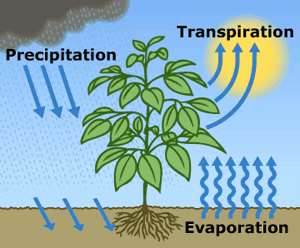Evaporation and Transpiration
Evaporation, condensation, and precipitation are the three most commonly discussed terms of the water cycle - but they aren’t the only parts of the cycle. One of the often-overlooked pieces of the cycle that shows the vital role of plants is called transpiration. Transpiration refers to the nearly invisible process of moisture being taken up by the root system from groundwater, up to the underside of the leaves, where it evaporates and releases back into the atmosphere.
The rate of transpiration changes depending on weather conditions, such as temperature, humidity, cloud cover, wind, and precipitation. The soil and plant type can also affect these rates. During a growing season, a plant can transpire more water than it weighs. For example, an acre of corn can transpire up to 4,000 gallons of water a day.
While the evaporation of water from oceans, lakes, and rivers account for most of the moisture in the atmosphere, nearly 10% of the total amount is provided through transpiration.

Source: USGS.gov